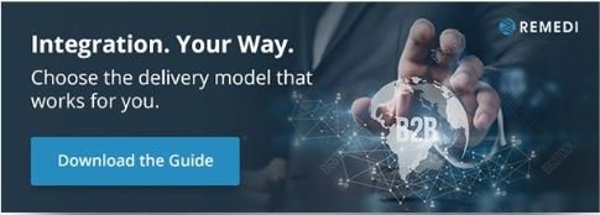 In today’s highly globalized world, businesses and even governments need a fast and simple way to transmit payments to one another. What is the solution? The answer is financial EDI.
In today’s highly globalized world, businesses and even governments need a fast and simple way to transmit payments to one another. What is the solution? The answer is financial EDI.
Financial EDI is the seamless transmission of payments, which not only fuel the global economy but allow governments to collect and distribute tax money as well. Read on to learn about what financial EDI is, how it works, how it came into existence, how it streamlines financial processes, and what factors will make financial EDI an even bigger part of the payment technology landscape.
What Is Financial EDI?
Electronic data interchange involves the electronic transfer of information in a standardized, machine-readable format. Similarly, financial EDI is the electronic transfer of payments, payment-related information, or other financial documents in a standardized, machine-readable format.
Businesses use financial EDI to transmit payments to one another. However, governments rely upon financial EDI to transfer tax payments. Financial EDI powers today’s globalized economy; without it, transferring payments on a massive scale would be slow and labor-intensive.
Questions about EDI integration and consulting? Ask me anything.
The Remedi AI Assistant may make mistakes. Please contact us with questions.
How Does Financial EDI Work?
To send a payment through financial EDI, there are a few steps that a company or institution undertakes.
The buyer electronically extracts payment information from the organization’s accounts payable system. That data is formatted into an EDI standard. Then, the transaction set is transmitted to the organization’s bank.
Next, the bank formats that information into the format necessary for its transmission through the Automated Clearing House (ACH) Network as an ACH transaction. The ACH network delivers the payment and its associated data to the seller’s bank, with the bank crediting the seller. It automatically transmits the payment information to the seller’s accounts receivable system, where the seller can see the funds have been posted.
The Evolution of Financial EDI
Financial EDI stems from the development of electronic data interchange. EDI owes its existence to Edward A. Guilbert, who served as a logistics officer in the US Army in World War II.
Guilbert was tasked with standardizing manifests during the Berlin Airlift. Almost 300,000 flights delivered vital goods throughout the operation. After the war, Guilbert took his logistics expertise to DuPont, where he developed the first electronic standardized messages.
The precursor to EDI was implemented in the transportation industry, which was badly in need of technology to automate communication. By the late 1960s, electronic messaging within the transportation industry had gained widespread popularity. However, the variations in formats caused confusion, helping to establish the Transportation Data Coordinating Committee (TDCC).
Guilbert served as president of the committee, which created the standards that would become ANSI X12 and modern EDI. Eventually, the standards TDCC developed spread to other industries, and around this time, the banking sector took an interest. By 1981, standards for the banking industry were published, allowing financial institutions to take advantage of the fast and efficient method of transmitting information (and payments).
How Does Financial EDI Streamline Processes?
The financial services industry is no stranger to complexity. Banks provide a wide array of services to their clients, and their clients are quite diverse. Retail and commercial clients have divergent needs, too. Clients, services, and processes generate a great deal of information. How do financial services organizations cope with the enormous flow?
Before financial EDI, the financial services industry relied upon paper processes. The problem with paper processes is that they are labor-intensive, error-prone, and downright efficient.
Financial EDI automates many of the processes in the financial services industry. Thanks to financial EDI, organizations can electronically receive an invoice and initiate a payment. For major companies, that ability saves time, paper, and money, both for the buyer and the seller.
Aside from saving time, paper, and money, automation enables companies to get paid faster. It takes less time to get paid electronically than it does by check. As a result, companies can optimize their cash conversion cycles.
Additionally, financial EDI provides a lower-cost alternative to paper-based payment methods. It can be expensive to process checks because of the need for human intervention. Financial EDI requires minimal human intervention. As you know, to err is human. Those errors are expensive, and by eliminating the need for human intervention, companies save money.

Real-Life Examples of How Financial EDI Streamlines Processes
The section above illustrates how financial EDI streamlines processes. However, without real-life examples, understanding how financial EDI benefits companies and organizations can be a bit hard to imagine. Below, we provide some common examples of financial EDI transaction codes:
- EDI 139 - Student Loan Guarantee Result. Loan guarantee agencies use EDI 139 to inform a lender or school about the status of a loan guarantee.
- EDI 144 - Student Loan Transfer and Status Verification. Lenders and guarantors use this transaction to send or receive information about transferring student loan ownership.
- EDI 154 - Secured Interest Filing. If you have to file Uniform Commercial Code (UCC) financing statement forms, liens, judgments, and other statements of secured interest, or exchange secured interest filing information, this is the code you use. As the UCC applies across the US, this is a very common transaction.
- EDI 812 - Credit/Debit Adjustment. Instead of sending a credit or debit memo, EDI 812 serves as a multi-directional notification to trading partners to let them know about adjustments and/or bill backs.
- EDI 820 - Payment Order/Remittance Advice. This transaction has two purposes: the first is to alert trading partners of an intent to pay an invoice, and the second is to order a financial institution to pay a seller.
- EDI 821 - Financial Information Reporting. EDI 821 reports balances, detail, summary financial transactions, and other related financial account information.
- EDI 823 - Lockbox. This transaction is the electronic version of a paper lockbox; it transmits incoming payment information and totals from a bank or any other lockbox service provider to a lockbox owner.
- EDI 827 - Financial Return Notice. Sometimes, a transaction cannot be processed by the originating financial institution. EDI 827 tells the originator that an 820 transaction cannot go through.
- EDI 828 - Debit Authorization. Payers use EDI 828 to provide information to a financial institution regarding authorized debits and it is often utilized in conjunction with ACH and/or EFT payments.
- EDI 829 - Payment Cancellation. A payer will use EDI 829 to cancel a previously authorized electronic payment from a financial institution prior to funds being released.
Why Will Financial EDI Become Even More Popular?
There are a few factors driving the adoption of financial EDI. They are:
- Healthcare payment requirements
- Increased B2B payments needed
- International payment regulations
- Governmental tax payment regulations
Healthcare payments are one set of payments driving the adoption of financial EDI. HIPAA mandates the use of EDI in the healthcare industry so that processes are more efficient. There are financial EDI transaction codes designed specifically for the healthcare industry: 835 for submitting payments, 820 for payroll deductions; NCPDP Telecommunications Standard version 5.1 for transmitting retail pharmacy claims; and 837 for submitting claim information.
Another factor is the increased business-to-business payments required. International trade is a fact of life; your suppliers are most likely no longer located on the same continent as you are anymore. Being able to pay, and to receive payments quickly, is crucial.
International regulations will drive increased financial EDI adoption, too. NACHA, the electronic payment association, requires payment gateway operators to submit remittance data for payments, making financial EDI a necessity. Financial EDI makes that possible, as information is transmitted seamlessly and quickly to those who need it.
Taxes are one of the certainties in life, and governments need a fast and efficient way to collect them, which is where financial EDI comes into play. The IRS uses the Electronic Federal Tax Payment System (EFTPS), a secure government website that allows users to make federal tax payments electronically. Electronic tax payment on such a massive scale requires a fast and easy way to process those remittances.
The federal government is not the only one who needs financial EDI for taxes; individual states levy taxes, too. Financial EDI allows them to quickly process (and pocket) those payments, so tax money can be allocated for vital programming.
How are Financial EDI Payments made?
The financial Electronic Data Interchange (EDI) payment process is automated and cloud-based. It's a new way for businesses to manage their accounts payable and receivable processes. This means that your business can easily use electronic payment methods like ACH payments, virtual cards, and wire transfers.
Financial EDI, or Electronic Data Interchange, is a method for exchanging business transaction data electronically between organizations. EDI allows you to send payments and receive real-time confirmation from your business partners.
Traditional paper check payment methods have been prevalent since the 70s, but they're slow and inefficient compared to electronic alternatives. A financial EDI payment can be made in just a few seconds—and processed within 24 hours (or even instantly). That's why financial institutions invest in these new technologies: they're faster, cheaper, and more secure than physical checks or wire transfers.
A financial EDI payment is an electronic transfer of funds made via a network such as the Clearing House Interbank Payments System (CHIPS), which The Clearing House Association LLC operates. Financial institutions use this system to settle their obligations to each other daily.
Financial EDI payments are most commonly used in banking, securities settlement, and insurance industries.
They allow two parties (buyer and seller) to agree on the price of goods or services and make the payment instantly without physically passing cash or checks back and forth. This is especially useful for high-volume transactions where invoices need immediate payment from customers.
The reasons for this are simple: They're fast, can be automated, and save you time and money.
You're not alone if your business is manually managing its financial EDI processes. In fact, many companies are still using this outdated method because of the time involved in implementing an automated solution. But manual processes are not scalable, prone to error, not secure, inefficient, and unreliable.
Financial EDI Barriers
Financial EDI is an exciting way to make your business run more smoothly and efficiently. However, there are some barriers to the creation of financial EDI solutions. Some of them are technical, while some are financial. They all have in common, though, that they need to be overcome if you want your business to succeed. Let's take a look at each one of these issues and what you can do about them.
Overcoming technical limitations and platform constraints.
Suppose your organization is interested in adopting financial EDI, and you're trying to figure out how to overcome the technical limitations and platform constraints preventing you from moving forward.
Eliminating system inefficiencies and avoiding new potential problems.
Eliminating system inefficiencies and avoiding new potential problems. Focusing on eliminating system inefficiencies and avoiding new potential problems is necessary for every organization that uses electronic data interchange (EDI) to exchange business documents between companies.
This is especially true when it comes to the healthcare industry, where healthcare providers are not only trying to avoid problems like fraud but also trying their best to provide the most accurate information possible when exchanging documents with each other and with clients.
Building an integration architecture that is scalable, reliable, easy to maintain, and invisible to the end-user.
The first step in building an integration architecture that is scalable, reliable, easy to maintain, and invisible to the end-user is designing the architecture. The type of integration technology you choose will depend on how your financial institutions work together. For instance:
- You'll need a gateway that supports those standards if you want to connect with one or more banks using a common standard like SWIFT MT-940 or ISO 20022 message formats.
- If your bank uses proprietary interfaces or has multiple systems with different functionality (e.g., core banking system and data warehouse), you might need an adaptor—a piece of software that translates messages between two incompatible architectures.
- If your bank wants its system updated only once per day (vs. live updates), then maybe it makes sense for them not to have direct access but rather receive nightly snapshots from another system within the same institution (e.g., daily data loads).
Gaining internal buy-in to achieve ROI from the investment in any financial EDI solution.
Most financial institutions do not take the time to define their EDI processes or convert them into use cases (though they should). Instead, they tend to focus on defining requirements in general terms such as "I want my trading partners' documents delivered electronically."
They also fail to define what architecture is required—whether you need an EDI gateway or a simple XML interface between applications. In addition, there is often little consideration given to how the solution will be implemented by IT staff and other departments within the bank; who will own that? Will those individuals have sufficient expertise?
And finally: Who owns training? Training costs are high regardless of whether you're using ETL tools or custom coding scripts and guides; if these silos aren't addressed early on in your project plan, then you're likely going down one path (i.e., considerable cost) without realizing there may be alternative ways which could potentially save money over time (i.e., no training).
Financial EDI has many barriers to overcome, but it will be worth your while once you have done so. Further, financial EDI will benefit your business in many ways, including:
- The ability to save money by reducing manual processes and errors
- Improved communication between departments within the organization
- An increase in productivity from better workflow management
How does EDI Differ from ACH and ETF?
EDI and ACH are the yin and yang of the business world. Both serve as an electronic alternative to traditional paper processes, yet they are more different than they appear on the surface.
ACH is a payment method that allows you to send or receive money from another bank account. ACH transfers are typically used for smaller payments such as utility bills, rent, or mortgage payments.
A financial institution uses the Automated Clearing House (ACH) network to process these transactions between banks and other financial institutions. The network is based on rules created by the National Automated Clearing House Association (NACHA), which was formed in 1972 and consists of approximately 300 participants representing all financial institutions, including banks and credit unions.
EDI is a standard for electronic data interchange. It runs off the common ANSI X12 standard and uses a transmission protocol called VAN (Value Added Network). EDI is a closed network that allows business partners to send and receive data within their organization but not outside of it. If you want to use EDI with other companies, they'll have to be part of your same network.
EDI is also secure because it uses encryption to ensure that no one else can access your private information.
Additionally, since it’s transmitted over a closed network, there's less chance of someone gaining access to your personal information while it's being sent through VAN.
Finally, EDI boasts reliability thanks to its automated system: Transactions are completed through batch processing rather than real-time processing like ACH and ETF do; this prevents any mistakes from occurring during transfers between two parties or companies.
EDI uses the Internet to exchange business documents, while ETF uses FTP servers.
EDI is an Internet-based system that allows companies to exchange business documents. ETF is a subset of EDI and uses FTP servers to exchange business documents. However, there are many differences between the two types of protocols:
- One difference between ETF and EDI is that ETF uses XML files while EDI uses all file formats (including XML).
- Another difference is that while they both use FTP servers, only ETF utilizes the Internet to send and receive information in real-time.
ACH transactions can be sent through multiple different platforms. The most common methods for sending ACH transactions are via email or a website, but they can also be sent through the proprietary platform of your bank (if you're lucky enough to have one) or via a third-party platform like PayPal or Square.
It's important to note that while these options are all similar in nature and function similarly, they differ in how they collect data from their users and process payments. For example, when you log into your bank account online and click "Pay Someone," this is an example of an ACH transaction being processed through a third-party platform because it happened online.
- ACH is a message-based system; EDI is transaction-based. That means that with ACH, you send a message to say, "here's my payment," and then it gets processed in batches asynchronously (meaning not in real-time). With EDI, you send all of your information at once along with your payment request, and then it's processed immediately upon arrival into your bank account or vendor's inbox.
- ACH takes more time than EDI because multiple steps are involved in processing payments; those steps require manual intervention and verification after each step has been completed—which can take days.
More and more companies and governments are using financial EDI to transmit payments, and for good reason. They understand that it is the best way to complete those processes because it automates payment transmission, so payments are received on time and all the information is correct. Contact Us to learn more about what financial EDI can do for your organization?



